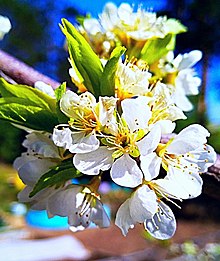Japanese cherry blossom

The Japanese cherry blossom ( Japanese 桜 sakura ) is one of the most important symbols of Japanese culture . It stands for beauty, awakening and transience ( mono no aware ). The cherry blossom season marks a high point in the Japanese calendar and the beginning of spring .
description

Usually referring to the blossoms of the Yoshino cherry tree ( Prunus × yedoensis ) and other cherry species native to Japan . The cherry blossom is also the official plant of Tokyo .
The cherry blossom begins in Japan in mid or late March in Kyūshū and then “migrates” to the northeast until it arrives in Hokkaidō around the beginning of May . During this time, the “ cherry blossom front ” ( 桜 前線sakura zensen ) is announced as part of the weather forecast . Spring plunges Japan into a pink and white sea of cherry blossoms (almost half of all deciduous trees in Japanese cities are cherry trees), which is why the cherry blossom season is also a preferred holiday and travel season in Japan.
During the ten days or so when the cherries are in bloom in their own area, almost all residents of Japan celebrate a hanami with friends, colleagues or family in a park or other excellent place, which takes on a folk festival-like character. O- Bentō and often plenty of beer or sake as well as a mat (large blue plastic tarpaulins are typical) to sit on the floor are among the utensils with which one gathers near and under cherry trees in the city and in the country. The evening hanami after work is particularly popular among colleagues and students. In some parks, the cherry trees ( 夜 桜 yozakura ) at night are illuminated for this purpose .
Just as the cherry blossom, so to speak, heralds the warm part of the year, this ends with the red color of the autumn leaves ( 紅葉 kōyō ).
The cherry blossom is a symbol of feminine beauty in Japan. One often reads that the cherry blossom was a symbol of transience for the samurai , but in this case it has been confused with the tsubaki ( camellia ).
According to the 2014 report by the National Institute for Land and Infrastructure Management, 522,353 cherry blossoms are planted as street trees in Japan. This is the second largest number of street trees.
The sakura song

The cherry blossom has been the subject of countless poems and songs since ancient times and creates a certain mood as a background in stories and films. Sakura, sakura is the name of a popular Japanese folk song :
| Japanese | Transcription | German translation |
|---|---|---|
|
さくらさくら |
Sakura, sakura |
Sakura (cherry blossom), sakura |
In 2007, the Office for Cultural Affairs, in cooperation with the umbrella organization of parent associations ( 日本 PTA 全国 協議 会 , Nihon PTA Zenkoku Kyōgikai ) put together a selection of 100 songs that are sung by children and parents. The Sakura, sakura was included in it at number 42.
Cherry Blossom Day
In 1992, the Japan Cherry Blossom Association issued Cherry Blossom Day on March 27th.
See also
- Hanami
- Japanese cherry blossoms (Japanese flowering cherry)
- Bird cherry
- Yokosuka MXY-7 »Ōka« (cherry blossom) - glide bomb for manned kamikaze attack (historical)
literature
- Gregor Garbassen: A country like being drunk . In: Rhein-Zeitung
Web links
Individual evidence
- ^ The Roadside Trees of Japan VII. In: TECHNICAL NOTE of the National Institute for Land and Infrastructure Management. February 2014, accessed on December 30, 2019 (jp).
- ↑ 親子 で 歌 い つ ご う 日本 の 歌 百 選 . Bunka-chō , 2007, archived from the original on March 6, 2015 ; Retrieved January 6, 2017 (Japanese).
- ↑ March 27, the day of the cherry blossom (3 月 27 日 さ く ら の 日 | な る ほ ど 統計 学園). Statistics Bureau of Japan, accessed March 22, 2019 (jp).



